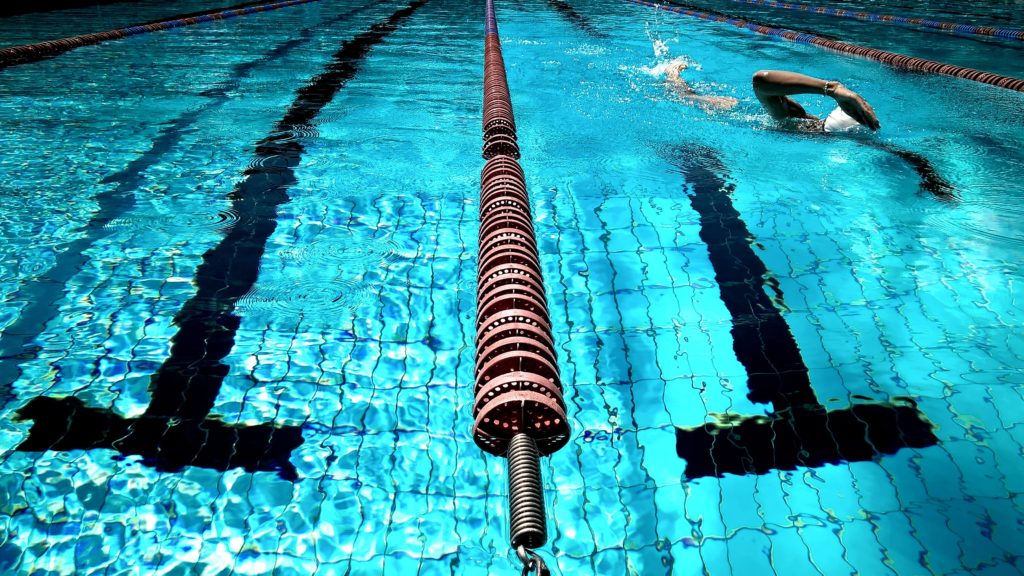Swim Drills – The How and Why

Like anything else in life, swimming takes practice to become stronger and more adept. Setting goals in swimming as a new athlete can be intimidating, especially if you have any fear or trepidation toward water. Fortunately, drills are here to help! Swim drills typically focus on one part of the body or one movement within the stroke, which allows the swimmer to hone in on their specific needs and fine-tune weak spots. I’ve been swimming for 16 years and still do drills almost every swim session. Here are some of my favorites, each targeting a different part of stroke development:
6 Swim Drills – The How and Why
Kick/Body Position- Sculling
Sculling is done with the hands, but has great benefits for those looking to gain more fundamental skills in their body position and kick. Sculling drills can be done in multiple ways, but the crux of the drill is the swimmer’s hands making a S- or figure-8 motion. The most common and useful methods of sculling for triathletes are the catch scull, where the swimmer’s hands are in front of them, elbows bent, and the swimmer kicks while making a sculling motion in front of them. The following video will help in visually understanding how these drills can be done: 8 Tips For Effective Sculling
Arm/Hand Position- Catch-Up
As a kid, I was taught that this drill was called “Ketchup” and it was like hitting your hand against the bottom of a stubborn ketchup bottle. Regardless of spelling, the catch-up drill is similar to this motion, but instead of squeezing some condiments onto your favorite sandwich or side, the goal is for the swimmer’s hands to “catch up” to one another. One arm will always be in front (the recovery arm), and the opposite arm will be completing a stroke in order to reach the first arm. This continues in a cycle through the planned distance, and is a great drill to practice in order to build proper form in the upper body throughout the stroke, as it guides your arms and hands into a rhythm and routine.
Elbow Position/Finger Position- Fingertip Drag
This drill is exactly what it sounds like. The swimmer drags their fingertips along the surface of the water in the catch of the stroke, focusing on keeping their fingers together and elbows high. This differs from the intent of the catch-up drill since the former is a more general upper-body drill. The fingertip drag forces the swimmer to ensure that their fingers aren’t letting extra water in during the entirety of the stroke and it guides elbow position while catch-up directs the motion of the arm over position.
Breathing (One-sided or Bilateral)- Single Arm Swim
In my decade of teaching swim lessons, one of the hardest skills for swimmers to build is proper breathing technique. Luckily, drills like single-arm swimming make it more manageable, and my students have always grasped it with time and effort! Single arm swimming involves completing a length of the pool only using one arm, with the other at your side- it can be still or sculling. This drill forces the swimmer’s body position towards that side and encourages breathing to the side rather than upwards. This drill is also versatile in that you can use the same arm each time or you can switch arms. For newer swimmers, my advice is always to use whatever breathing technique is most comfortable. A single-sided breather can always transition to bilateral breathing as they improve their ability. Breathing to the side is a huge game changer in energy efficiency, body positioning, and speed. If I was to recommend only one drill to a new swimmer, it’s generally this one or six kick and roll, which you can read about below.
Hip Rotation- Six Kick and Roll
More than one of my swim coaches growing up said during practice, “if your freestyle is good, you’ll never be swimming on your stomach,” and this is never more true than with the six kick and roll drill. Like the fingertip drag drill, this is exactly what it sounds like: the swimmer starts on one side, kicks six times, and rolls to the other side. This drill allows swimmers to get a feel for swimming on their side and relying on hip motions to propel the body forward. Additionally, this drill can also help with one-sided, bilateral breathing, since any breathing at the front of the body will drag the rest of the body down and mess with the drill.
Sighting- Tarzan
The Tarzan drill flips the “six kick and roll” drill on its head, but for good reason. In open water swimming, sighting is critical! In a pool swimming format, the swimmer is in a more contained and exact space, so breathing to the side is sufficient for knowing where they are in the pool. However, open water swimming requires a different kind of sighting, where a swimmer will often have to look forward. This drill is a favorite in kids’ swimming because not only are your arms swinging wildly about, coaches would sometimes allow us to yell like Tarzan while doing it! The Tarzan drill involves a swimmer keeping their head above water while kicking enough to keep the body at the surface of the water and then completing strokes without putting their face back in the water.
Drills can break up the monotony of laps while also helping you build a more efficient stroke and confidence in the water. We would love to hear from you if you’ve tried these drills or any other drills you like to do in the water!

Danielle Moore is a swimmer and triathlete living outside Philadelphia, Pennsylvania. Her athletic journey picked up at 10 years old when she started swimming in the summers, and ended up as a butterflyer for both her high school and college teams. She ran track in middle and high school as well, but swimming is her true passion in sports. Danielle has also been teaching swim lessons since 2010 and received her US Masters Swimming Level 1 Coach certification in March 2022. She raced her first sprint triathlon in 2019 and has been hooked ever since- she will be racing her first half Ironman in September 2022.









